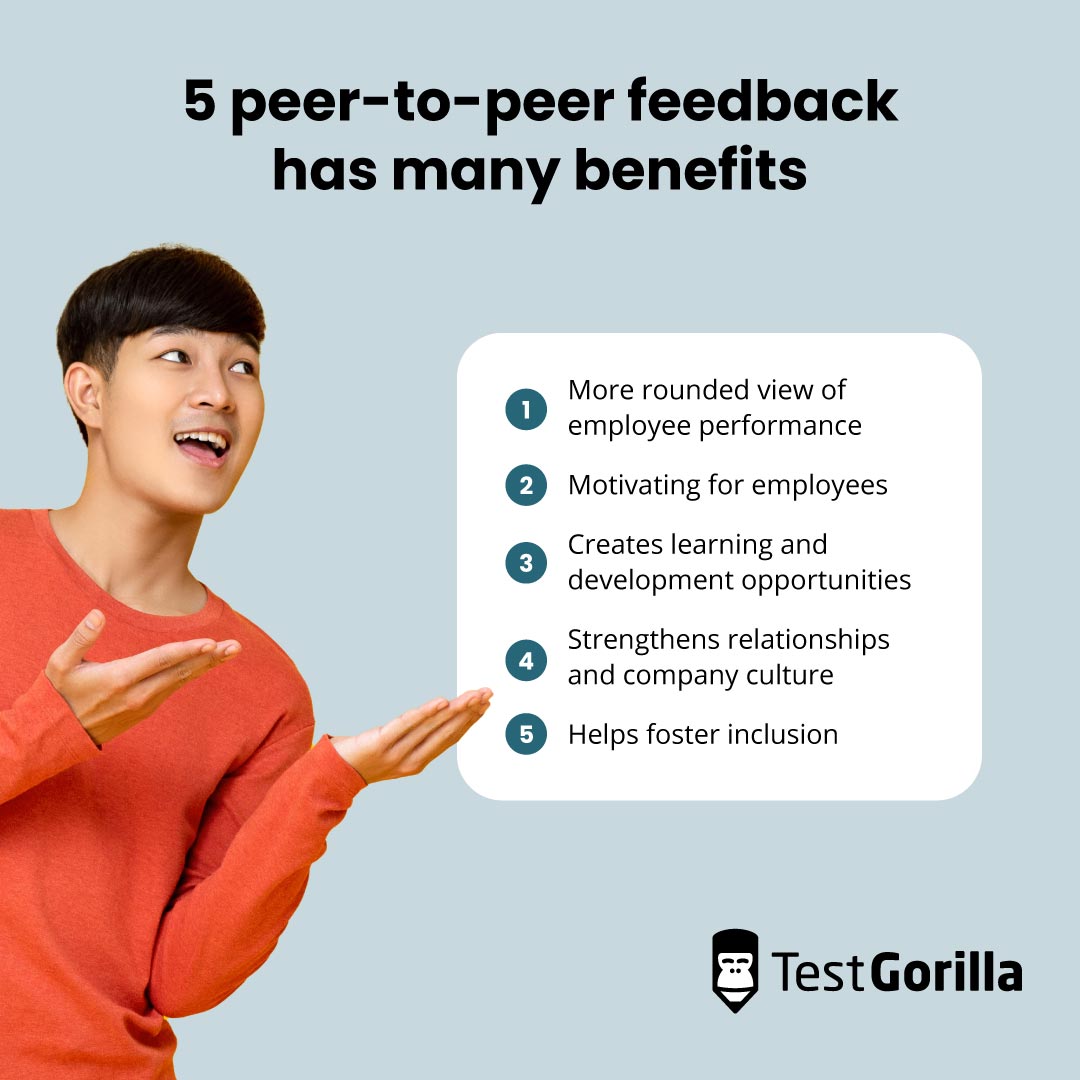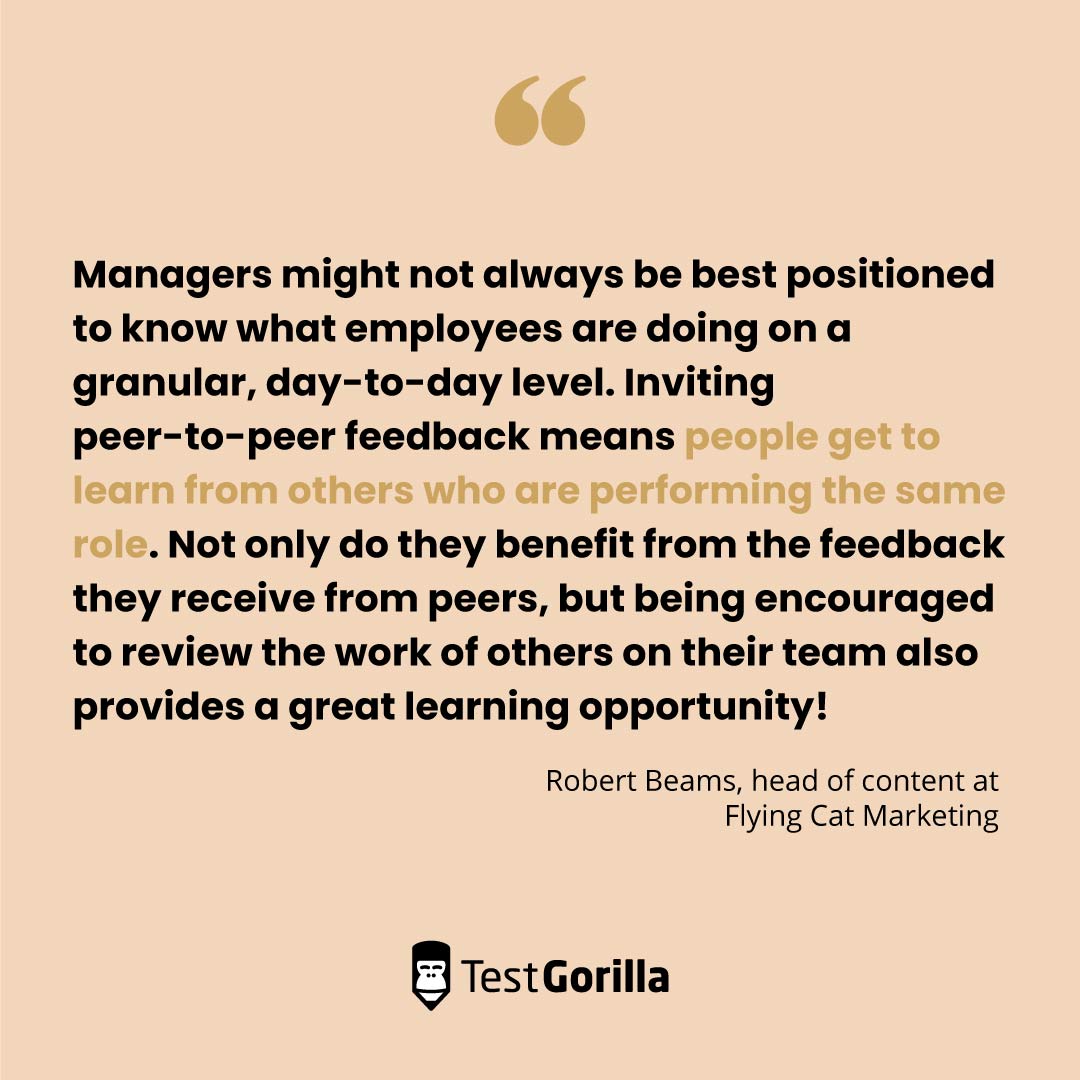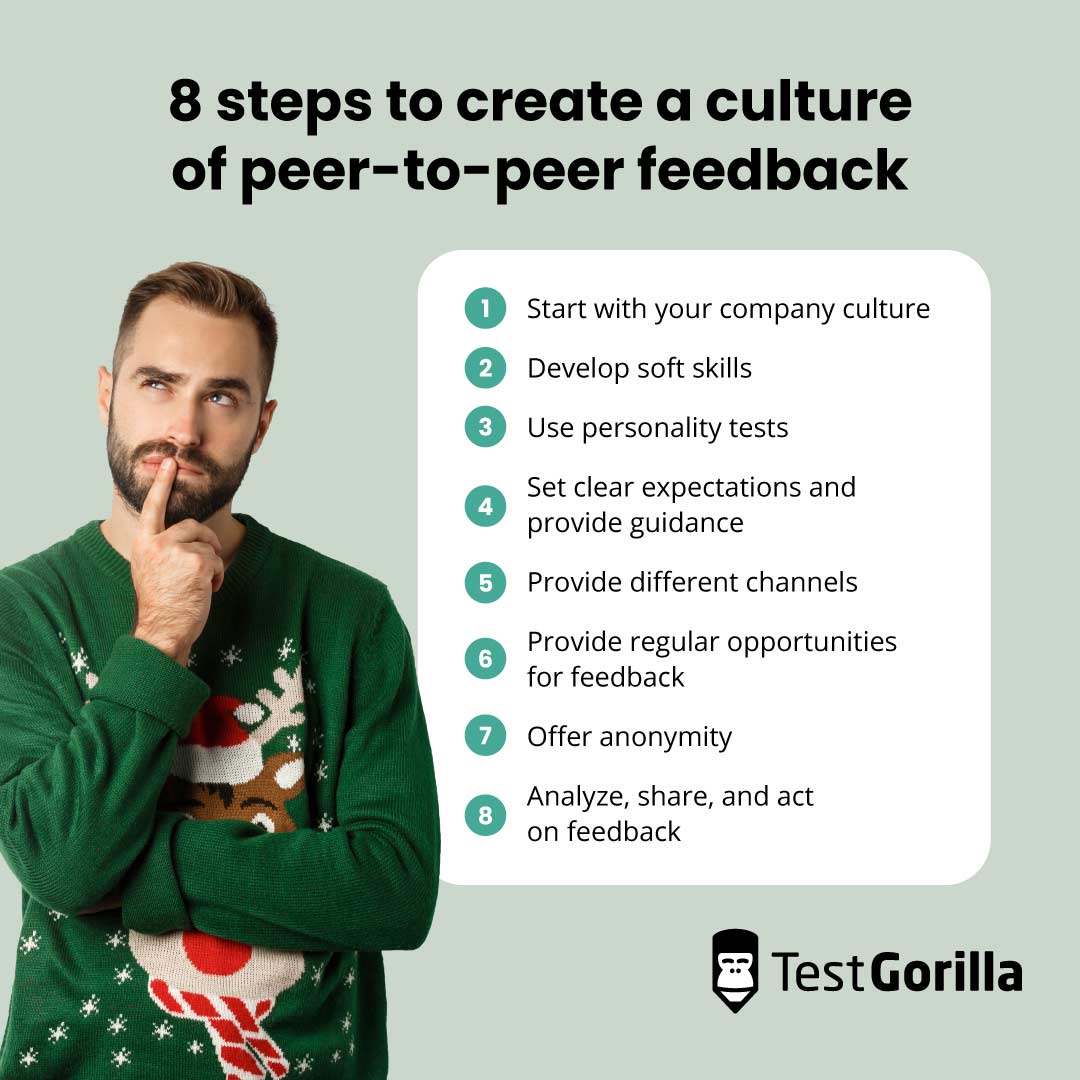The power of peer-to-peer feedback for employee skills development
It’s employee review time again and you can’t shake the feeling you’re missing something.
Why does Malcolm from accounts always get top marks but have few friends on the team? Why is neurodiverse Lindsey marked down despite being a hard worker? Maybe her manager just doesn’t “get” her communication style?
Standard performance reviews can be biased and leave gaps in your understanding of employee capabilities and behavior.
Peer-to-peer feedback fills these gaps with insights from those who work closely with employees daily. This lets you accurately pinpoint areas of excellence and improvement.
However, giving and receiving feedback needs to be handled carefully to avoid damaging relationships.
In this post, we’ll explore the benefits and challenges of peer-to-peer feedback and how to create a feedback culture that results in positive learning opportunities. Additionally, we’ll explain how to use talent assessments to develop the soft skills employees need to make feedback a success.
How peer-to-peer feedback benefits your employees and organization
From improving skills, knowledge, and motivation to building connected teams, peer-to-peer feedback has many benefits.
Let’s take a look at five of them in depth below.
1. More rounded view of employee performance
Traditional top-down performance reviews don’t provide the whole picture of employee performance and behavior, especially if their interactions with managers are limited.
Peer feedback provides input from people who can comment on their day-to-day work and the behaviors that directly impact team cohesion and performance, which a manager may not see.
Including additional, on-the-ground perspectives gives a more comprehensive view of employee performance and skills gaps. Gathering multiple opinions also helps avoid subjective bias from managers that can lead to unfair assessments.
"Managers might not always be best positioned to know what employees are doing on a granular, day-to-day level. Inviting peer-to-peer feedback means people get to learn from others who are performing the same role. Not only do they benefit from the feedback they receive from peers, but being encouraged to review the work of others on their team also provides a great learning opportunity!"
– Robert Beams, head of content at Flying Cat Marketing.
2. Motivating for employees
When employees feel listened to – and that their input is valued – it builds trust, which boosts engagement and retention. Trusting workers are 260% more motivated and 50% less likely to look for another job.[1]
Open peer-to-peer recognition like shoutouts is highly motivating, which helps overcome the problem of lack of recognition, a major cause of employee turnover.
3. Creates learning and development opportunities
Peer-to-peer feedback exposes employees to different perspectives and ideas that they can learn from. It’s also great to practice soft skills like clear communication, active listening, and conflict management. These are helpful for team communication and essential for leadership.
By identifying skills gaps, it creates opportunities for peer-to-peer learning or mentoring. This is highly motivating for both parties, and tapping into internal expertise can be more effective – and cheaper – than traditional learning methods.
When employees see peers being vulnerable and open to feedback, it encourages them to do the same, which makes them more receptive to learning from it.
4. Strengthens relationships and company culture
Peer-to-peer feedback helps identify barriers to teamwork and cohesion. Imagine an employee has a different working style that causes bottlenecks and frustration. Peer input lets leaders identify the problem and work with the employee to resolve it.
Peer-to-peer recognition nurtures relationships and makes people feel more connected to teammates and your organization, which motivates them to go the extra mile. Learning about each other’s strengths and weaknesses can also promote understanding and mutual appreciation.
A culture of candid feedback that comes from a place of caring encourages openness and honest communication, which helps avoid toxic behaviors like passive aggressiveness.
Finally, peer-to-peer learning helps break down silos and barriers between employees and departments.
Creating a culture where managers solicit feedback from employees can also facilitate the complementary practice of gathering employee feedback on leadership.
5. Helps foster inclusion
When diverse employees share their experiences, it’s easier for coworkers to understand what they’re experiencing. This drives empathy and inclusion and gets issues like microaggressions out in the open so you can address them.
Now you know the benefits of peer-to-peer feedback, let’s take a look at how to implement it in your organization.
8 steps to create a culture of peer-to-peer feedback
Creating a positive culture of peer-to-peer feedback starts with company culture and continues with skills, all within clear guidelines.
Let’s take a look at what that involves.
1. Start with your company culture
To enable peer-to-peer feedback, you need to create the right conditions: a positive company culture where people can speak their minds.
Here’s how:
Set strong shared values, like radical candor, trust, empathy, and psychological safety, which allow people to speak up without fear of negative consequences. Use team building events and activities to establish and reinforce these.
Hire the right people. Use talent assessments to measure essential skills like open communication, active listening, and taking feedback on board. Our Culture add test can also help determine whether new hires will provide fresh perspectives or just fit in with the crowd.
Maintain a growth mindset. People who are open to constructive criticism can learn from it and improve, rather than getting defensive or demotivated.
Celebrate wins. Encourage people to shout others out on Slack or in team meetings. This boosts motivation and gives the rest something to aim for.
Promote inclusivity. Recognize team members who are less often in the spotlight – like new hires, remote, or “backroom” employees – to avoid favoritism and boost inclusion.
2. Develop soft skills
Giving and receiving feedback are skills that don’t always come naturally, which can cause people to avoid feedback entirely.
Here are a few soft skills that make peer review a pleasure, not a punishment:
Empathy. This makes for more productive conversations and stronger relationships. Encourage people to put themselves in recipients’ shoes when giving feedback. How would they feel if the tables were turned?
Respect. Those giving feedback must be mindful of the recipient’s professional pride and feelings. For their part, recipients may disagree with feedback, but they still need to be professional, not dismissive, and thank others for their contributions.
Curiosity and open-mindedness. These allow people to improve from feedback and ask clarifying questions rather than arguing, which makes for more growth opportunities.
Pro tip: Use talent assessments to close skills gaps. For instance, our Communication skills test assesses how clearly, effectively, and professionally people communicate, including written and verbal communication, non-verbal cues, and active listening. You can also use our Leadership and people management test to develop leaders who can sensitively manage the peer feedback process and deal with issues like bruised egos.
3. Use personality tests
Personality tests reveal individual traits and preferences, like how people perform under pressure. This helps them understand each other better, which promotes empathy.
Incorporating personality testing into your review process discourages non-constructive feedback about things that can’t be changed because it’s just how someone is. For example, it’s unhelpful to criticize a severely introverted colleague for not leading more meetings.
Some personality tests to consider:
4. Set clear expectations and provide guidance
Feedback is rarely 100% objective; it’s influenced by personal preferences, feelings, bias, and emotions. Additionally, negative feedback is especially difficult to navigate when peers have a close relationship.
This means you need to establish clear criteria and expectations to ensure consistency, fairness, and effectiveness.
Think about the standards and expectations for employees and how peer feedback can feed into performance reviews. What is and isn’t it helpful for peers to comment on?
Next, who should give feedback on whom? The obvious choices are people who work closely together, but input from other departments can also be gold and help create a clearer picture.
Here are some best practices for a standardized, productive approach to giving feedback:
Come prepared. Those providing feedback should prepare a list of specific points to address and know what they want to say, to keep sessions short and productive.
Assume, and have, good intentions. Feedback should come from a place of caring and a desire to help others improve, not blame them. Wording, tone, and non-verbal cues should all support this so coworkers feel supported, not attacked.
Understand communication preferences. Some people prefer feedback straight up; others need careful handling. Have people share their preferences with the team so everyone’s aware.
Be objective and specific. Stick to observations and experiences, rather than subjective judgments that aren’t backed up by evidence. For example, instead of “You’re always late with your tasks because you’re lazy,” try “You were late with tasks on X occasions this month.”
Be constructive. There’s no benefit in criticizing what can’t be changed. Feedback should be constructive and focus on behaviors that peers can address. Then, follow up with some positives so it feels balanced and fair.
Use feedback frameworks. These make it easier to communicate issues. For example, you could try the Situation Behavior Impact model, Strengths Action Impact Development, the Stanford method, or the McKinsey Feedback Model.
5. Provide different channels
Not everyone feels comfortable discussing feedback face-to-face, especially in a group setting, so you should make various channels available.
Here are some to consider:
Team meetings and communication channels. Set up a dedicated Slack channel for shoutouts and devote some time to wins in team meetings. The more frequent and immediate recognition is, the more rewarding.
Retrospectives and reviews. Timely group reflection on projects, failures, or successes yields valuable learnings. The two-way nature of these sessions means peers are more likely to be respectful and constructive.
Team building activities and workshops. People are more relaxed in less formal situations like retreats, offsites, or courses, so it’s easier to be open.
Office hours and 1:1s. As well as scheduled 1:1s, “open office” slots allow anyone to show up and chat informally with leaders.
Surveys. Regular employee surveys should include specific, targeted questions to ensure objective answers.
Suggestion boxes or feedback forms. Whether physical or virtual, these let people provide feedback outside dedicated times or channels, which is especially important for remote workers in other time zones.
6. Provide regular opportunities for feedback
Feedback should be an ongoing exchange, not a one-off thing. The more often employees do it, the better they’ll get at it – and the faster their performance will improve.
Bi-annual surveys alone won’t provide the timely input that enables growth, but neither should you overwhelm employees with demands every week.
Survey employees to find a middle ground – perhaps monthly or quarterly – and which channels they prefer. Frequency may also be determined by how your teams work. For example, right after a sprint or project milestone, when things are still fresh in people’s minds.
Whatever you establish, make it clear that people can leave unsolicited feedback anytime via certain channels like a website form.
7. Offer anonymity
Some employees will still feel uncomfortable openly giving feedback, even with the most positive company culture.
Provide anonymous feedback channels, like website forms or surveys that don’t require personal information. Be aware, though, that anonymity can lead to less sensitivity to others’ feelings, so reaffirm your shared values regularly, especially before soliciting feedback.
8. Analyze, share, and act on feedback
Feedback is useless if you don’t act on it, and demotivating for givers who don’t see any results.
Incorporate peer-to-peer feedback into performance reviews so leaders can help employees reflect and identify patterns, trends, and areas for improvement. Managers should also provide strategies to address them.
For maximum benefit, tie individual objectives into company goals. Remember to shout employees out when they hit development milestones for positive reinforcement.
The best insights on HR and recruitment, delivered to your inbox.
Biweekly updates. No spam. Unsubscribe any time.
Peer-peer feedback: A powerful tool for employee development
Peer feedback complements top-down performance reviews with more varied, real-time, “real-life” perspectives. It also helps identify skills gaps and develop the soft skills that make feedback a positive experience – and that employees need to progress to leadership.
Peer feedback can be highly motivating and provide learning and development opportunities. It also helps create a positive company culture and strong relationships, and boosts inclusion by allowing diverse employees to share lived experiences.
To create a culture of peer feedback:
Establish values like trust, empathy, and open communication
Hire people with a growth mindset who live by those values
Encourage peer-to-peer recognition
Use talent assessments to develop the soft skills necessary to give and receive feedback
Use personality tests to help employees better understand each other
Provide clear expectations, guidance, and feedback frameworks
Create various feedback channels, including anonymous ones, and make it a regular thing
Facilitate learning from feedback
Once you’ve done this, you’ll have a positive culture of peer feedback where everyone owns employee development and growth.
Build better-performing, more connected teams.
Talent assessments help develop the soft skills employees need to benefit from peer feedback.
Sources:
“How to Build a High-Trust Workplace.” (2023). MIT Sloan Management Review. Retrieved September 4, 2023.
Related posts
You've scrolled this far
Why not try TestGorilla for free, and see what happens when you put skills first.





















